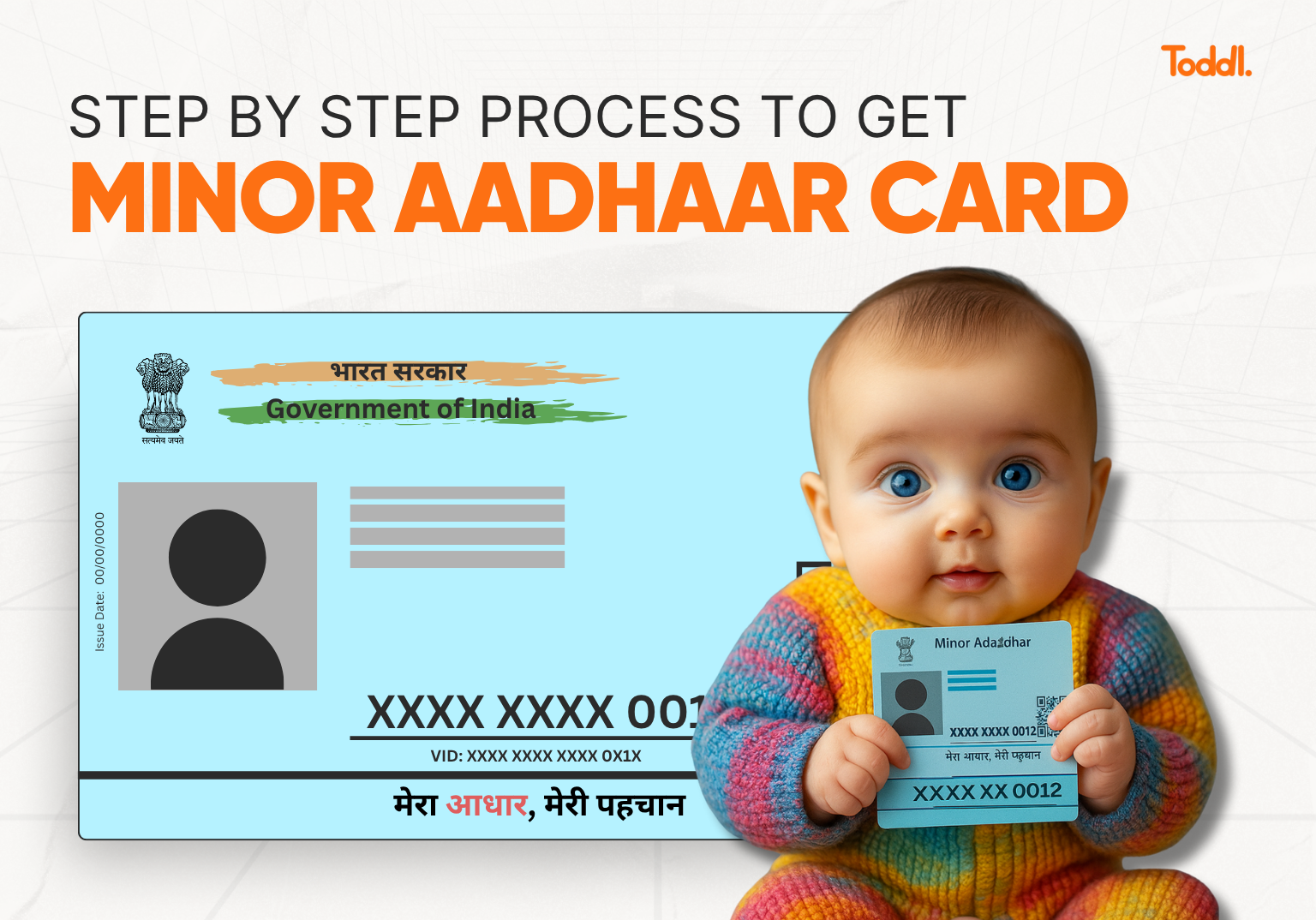
Every milestone in a child’s life starts with a small, foundational step. First smile. First school. First ID. In today’s digital-first world, identity begins early — and increasingly, that first official identity is the Minor Aadhaar Card. It’s not just another document. It’s your child’s gateway to healthcare, school admissions, bank accounts, investments, and more.
While it may seem like something to think about “later,” Aadhaar for minors — especially infants and toddlers — is becoming an essential part of future-proofing your child’s access to key services and opportunities.
Let’s break down what a Minor Aadhaar Card really is, why it matters, and how to get one — step by step.
Why this matters
In the past, a child’s ID was something most parents thought about only during school admissions. But today, Aadhaar has become the anchor for everything — from opening a minor savings account to starting a mutual fund SIP in your child’s name.
With Aadhaar being used to reduce fraud in welfare schemes, simplify digital KYC, and make financial onboarding seamless, its relevance has grown — not just for adults but for children too. As parents start planning earlier for their child’s future, a minor Aadhaar card is becoming the invisible key that quietly unlocks it all.
What is a Minor Aadhaar Card?
The minor Aadhaar card is the Aadhaar version issued to children below 18 years. For children under 5, it’s called the Baal Aadhaar — distinguishable by its signature blue colour and lack of biometric data. It acts as the child’s first official proof of identity and is linked to one parent’s Aadhaar for authentication.
There’s no age limit to apply — even newborns are eligible. That’s right, the aadhaar minimum age is zero. This early enrolment ensures your child has a verified identity from day one — a necessity for accessing several government and financial services in India.
Baal Aadhaar vs Regular Aadhaar: What’s the Difference?
To make sense of it, here’s how Aadhaar evolves with your child’s age. Think of it as a growing ID that updates as your child grows up.
Baal Aadhaar (Below 5 years)
- The iconic blue Aadhaar card, often called blue Aadhaar, is issued to children under five.
- No biometric data (fingerprint or iris) is captured at this stage — only a photograph is taken.
- The card is linked to a parent’s Aadhaar for identity validation.
Age 5–15:
- Biometric update is mandatory at age 5. Fingerprints, iris scan, and a new photograph are collected.
- The card transitions from Baal Aadhaar to a regular minor Aadhaar card, but it’s still under the parent’s guardianship.
Age 15+:
- A second biometric update is required.
- This ensures the Aadhaar remains valid as your child becomes eligible for financial independence.
Smooth transitions between these stages ensure that Aadhaar grows with your child — keeping their ID accurate and usable across platforms.
Real-Life benefits of the Minor Aadhaar Card
Before we get into the how-to, let’s look at the why. Aadhaar’s benefits go far beyond a plastic card. For children, the uses are practical, long-term, and surprisingly wide-reaching.
1. School Admissions & Identity Verification
Many private and public schools — especially CBSE-affiliated ones — ask for Aadhaar during admissions. While it’s not legally mandatory, having it can speed up the paperwork and eliminate issues with age or identity discrepancies.
2. Government Welfare Access
Schemes like vaccination tracking, insurance (like Ayushman Bharat), or mid-day meals often use Aadhaar to authenticate beneficiaries. It helps reduce duplication and ensures rightful access to these services.
3. Passport Issuance
Aadhaar is accepted as identity proof when applying for a minor’s passport. It streamlines documentation and verification at the passport office.
4. Banking & Digital KYC
Opening a bank account for your child? Most banks now ask for the minor Aadhaar card as valid proof of identity and age. Plus, Aadhaar makes e-KYC fast and seamless.
5. Investments in Child’s Name
Planning to invest in mutual funds or start a SIP for your child?
Although the parent or guardian can complete KYC using other OVDs like a passport or voter ID, and the child’s age can be verified with a birth certificate or other documents.
Aadhaar simplifies paperless KYC verification for the guardian on platforms, enabling “KYC Validated” status for seamless transactions across AMCs.
These benefits aren’t one-offs — they lay the foundation for your child’s financial identity, helping you plan smarter, sooner.
The application process: How to get a Baal Aadhaar Card
If you’re wondering how to apply, here’s a breakdown — and yes, you can start right after your child is born.
Step 1: Visit an Aadhaar Enrolment Centre
Look for a UIDAI-authorised centre — available in most post offices and banks. You can find one on the UIDAI website.
Step 2: Fill the Enrolment Form
Basic details of the child are collected along with one parent’s Aadhaar number for linking.
Step 3: Submit Required Documents
Here are the documents required for minor Aadhaar card:
- Birth certificate or hospital discharge summary
- Aadhaar of either parent/guardian
- Passport-size photograph of the child
Step 4: Photo Capture
For children under 5, only the child’s photo is taken — no biometrics needed.
Step 5: Aadhaar Generation and Delivery
You’ll receive an acknowledgement slip. The Aadhaar card (or e-Aadhaar) is delivered in 2–6 weeks, sometimes earlier.
The online application isn’t fully paperless yet, but you can book appointments and check status via UIDAI. The search for baal aadhaar online often lands you here.
Keeping Aadhaar updated: A must for the Long Term
Getting the Aadhaar card isn’t the end of the story — it’s important to update it at key milestones.
At Age 5:
- Your child’s fingerprints, iris scan, and photo are updated.
- This ensures the card remains valid and usable for services like school exams or child insurance.
At Age 15:
- A second biometric update is mandatory.
- This helps transition the baal aadhaar card into an adult-ready identity proof.
Failure to update could make Aadhaar invalid for things like future bank accounts or scholarship applications.
Why the Minor Aadhaar Card is more than just ID
If you’re still wondering whether it’s really necessary — think of the minor Aadhaar card as a foundation stone. One that anchors everything from your child’s school experience to their first investment.
It Builds Financial Inclusion from the Start
By linking Aadhaar to bank accounts, mutual funds, or SIPs, you’re opening financial doors early — giving your child a head start that compounds over time.
It’s a Trust Layer in the Digital World
Whether you’re using Aadhaar for vaccination benefits or future college fund investments, it adds a secure digital verification layer that simplifies your life and protects your child’s access.
It Grows as Your Child Grows
From a blue card to a full-fledged financial document, Aadhaar evolves with your child. This continuity means no disruptions when it’s time to apply for loans, jobs, or IDs later on.
Key takeaways
- Aadhaar is voluntary — but practically essential.
- The blue Aadhaar card is issued from birth and helps in banking, schooling, and more.
- It enables e-KYC for mutual funds and is now required for “KYC Validated” status under new SEBI norms.
- Regular biometric updates at ages 5 and 15 keep it functional.
- It lays the financial groundwork for your child — from SIPs to insurance.
Conclusion
Aadhaar may not shout for your attention — but it quietly powers some of the most important decisions in your child’s life. From opening a bank account to unlocking a scholarship or kickstarting an SIP — it all begins with the minor Aadhaar card.
So why wait?
At toddl, we make it easy to save and invest for your child — all in one place. Aadhaar-linked onboarding means you can get started quickly and securely.
Let your child’s financial journey begin — with identity, intention, and a plan.
Start early. Start with Aadhaar. Start with toddl.
FAQs
1. What is a blue Aadhaar card and who gets it?
It’s a child-specific Aadhaar card issued to kids under 5. It’s blue in colour and doesn’t include biometrics. Parents’ Aadhaar is used for authentication.
2. What is the minimum age to apply?
There’s no minimum age — even newborns are eligible for Aadhaar enrolment.
3. Can I apply for a baal aadhaar card online?
You can’t fully apply online, but appointment booking and status tracking are available via the UIDAI portal.4. What if I don’t update Aadhaar at 5 or 15?
Without biometric updates, the Aadhaar may become invalid for legal and financial services — affecting school records, investments, and more.


